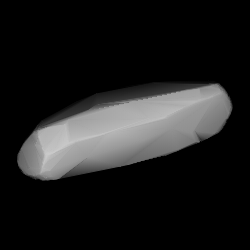4349 Tibúrcio, provisional designation 1989 LX, is a dark asteroid from the central region of the asteroid belt, approximately 29 kilometers in diameter. It was discovered on 5 June 1989, by German astronomer Werner Landgraf at ESO's La Silla Observatory in northern Chile.
6433 Enya, provisional designation 1978 WC, is a stony background asteroid from the inner regions of the asteroid belt, approximately 7 kilometers in diameter. It was discovered on 18 November 1978, by Czech astronomer Antonín Mrkos at the Kleť Observatory in the Czech Republic. It was named for Irish musician Enya.
5677 Aberdonia, provisional designation 1987 SQ1, is a stony Koronis asteroid from the outer region of the asteroid belt, approximately 8 kilometers in diameter. It was discovered on 21 September 1987, by American astronomer Edward Bowell at Lowell's Anderson Mesa Station in Flagstaff, Arizona, United States. The asteroid was named for the Scottish University of Aberdeen.
16765 Agnesi is a stony Eunomia asteroid from the middle region of the asteroid belt, approximately 4 kilometers in diameter. It was discovered on 16 October 1996, by Italian-American amateur astronomer Paul Comba at his private Prescott Observatory in Arizona, United States. The asteroid was named after Italian mathematician Maria Gaetana Agnesi.
4151 Alanhale, provisional designation 1985 HV1, is a carbonaceous Themistian asteroid from the outer region of the asteroid belt, approximately 19 kilometers in diameter. It was discovered by the American astronomer couple Carolyn and Eugene Shoemaker at the U.S. Palomar Observatory, California, on 24 April 1985. It was named for American astronomer Alan Hale.
2033 Basilea, provisional designation 1973 CA, is a stony asteroid from the inner regions of the asteroid belt, approximately 6 kilometers in diameter. It was discovered on 6 February 1973, by astronomer Paul Wild at the Zimmerwald Observatory near Bern, Switzerland. The asteroid was named for the Swiss city of Basel.
29292 Conniewalker (provisional designation 1993 KZ1) is a bright, stony Phocaea asteroid and slow tumbler from the inner regions of the asteroid belt, approximately 4.6 kilometers in diameter. It was discovered on 24 May 1993, by American astronomer Carolyn Shoemaker and Canadian astronomer David Levy at the Palomar Observatory in California, United States.
1991 Darwin, provisional designation 1967 JL, is a stony Florian asteroid from the inner regions of the asteroid belt, approximately 5 kilometers in diameter.

1665 Gaby, provisional designation 1930 DQ, is a stony asteroid and a relatively slow rotator from the inner regions of the asteroid belt, approximately 11 kilometers in diameter. It was discovered on 27 February 1930, by German astronomer Karl Reinmuth at Heidelberg Observatory in southern Germany. It was later named after Gaby Reinmuth, the discoverer's daughter-in-law.
2571 Geisei, provisional designation 1981 UC, is a stony Florian asteroid from the inner regions of the asteroid belt, approximately 6 kilometers in diameter. It was discovered by Japanese astronomer Tsutomu Seki at Geisei Observatory on 23 October 1981, and named for the Japanese village of Geisei.

1251 Hedera is a background asteroid from the central regions of the asteroid belt, approximately 13 kilometers in diameter. It was discovered on 25 January 1933, by German astronomer Karl Reinmuth at the Heidelberg-Königstuhl State Observatory in southwest Germany. The asteroid was named for the climbing plant Hedera, commonly known as "ivy".
2028 Janequeo, provisional designation 1968 OB1, is a stony Florian asteroid from the inner regions of the asteroid belt, approximately 3 kilometers in diameter. It was discovered on July 18, 1968, by Chilean astronomers Carlos Torres and S. Cofre at the Cerro El Roble Station of Chile's National Astronomical Observatory. The asteroid named after the indigenous heroine Janequeo (Yanequén).

2156 Kate is a highly elongated background asteroid from the inner regions of the asteroid belt. The asteroid was discovered on 23 September 1917, by Soviet–Russian astronomer Sergey Belyavsky at the Simeiz Observatory on the Crimean peninsula. It was named for Kate Kristensen, wife of astronomer L. K. Kristensen. The bright S-type/A-type asteroid has a rotation period of 5.6 hours and measures approximately 8 kilometers in diameter.
1771 Makover, provisional designation 1968 BD, is a carbonaceous asteroid from the outer region of the asteroid belt, approximately 50 kilometers in diameter.
1405 Sibelius, provisional designation 1936 RE, is a stony Florian asteroid from the inner regions of the asteroid belt, approximately 8 kilometers in diameter. It was discovered on 12 September 1936, by Finnish astronomer Yrjö Väisälä at Turku Observatory in Southwest Finland. The asteroid was named after composer Jean Sibelius.
17163 Vasifedoseev (provisional designation 1999 LT19) is a stony Koronian asteroid from the outer region of the asteroid belt, approximately 4 kilometers in diameter.
3823 Yorii, provisional designation 1988 EC1, is a carbonaceous asteroid from the outer region of the asteroid belt, approximately 11 kilometers in diameter.
4760 Jia-xiang, provisional designation 1981 GN1, is a background asteroid from the inner regions of the asteroid belt, approximately 5 kilometers (3 miles) in diameter. It was discovered on 1 April 1981, by astronomers at Harvard University's Oak Ridge Observatory in Massachusetts, United States. The presumed stony S-type asteroid was named after Chinese astronomer Zhang Jiaxiang. It has a rotation period of 14.96 hours.
6102 Visby, provisional designation 1993 FQ25, is a stony background asteroid from the central region of the asteroid belt, approximately 5 kilometers (3.1 miles) in diameter.
12564 Ikeller, provisional designation 1998 SO49, is a stony Koronian asteroid from the outer region of the asteroid belt, approximately 5 kilometers in diameter.



